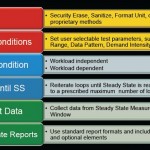Join Tom Coughlin, Marketing Chair, SNIA SSSI and President, Coughlin Associates, for an informative SNIA Solid State Storage Initiative webcast on Tuesday, November 29, 2011 at 11:00 am PT/2:00 pm ET.
Solid Security: The Rise of Self-Encrypted Solid State Drives
http://www.brighttalk.com/webcast/663/37987
Protecting user data is important in storage devices. If valuable information is on a storage device, it makes sense to make sure that that data isn’t accessible by unauthorized individuals or organizations. Protecting user data from being stolen or accessed leads to the use of encryption in storage devices.
With one of the hottest drive categories – solid state drives (SSDs) – rapidly penetrating data centers, this hour-long webcast provides a valuable introduction to self-encrypting drives (SEDs) and explains why organizations need SEDs Solid State Drives in their environment. Listen, ask questions, and find out from your peers where they are in incorporating SEDs and SSDs in their environment.
